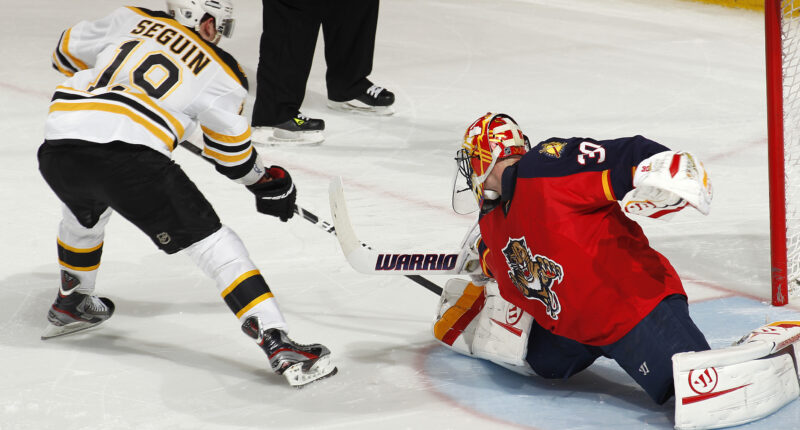Find out “Can A Hockey Game End In A Tie” No, a hockey game cannot end in a tie in a professional match. It is valid in NCAA and other recreational matches.
When both teams have the same score at the end of the play, no one can be declared the winner. A tiebreaker is used in such situations.
Each sport has its own method for determining a winner when a game ends in a tie.
Hockey’s regular season ends with a 3-on-3 overtime followed by a shootout. However, the playoffs add a sudden death 20-minute overtime.
In the professional major leagues, teams play for titles and trophies, however, collegiate and recreational games may end in draws.
What Is A Tie In Hockey Called?
A professional hockey game never ends in a tie. However, the children’s and college-level plays can be ended in a draw if both teams agree to it.
During the inception of ice hockey, many games used to finish in a draw. It created chaos in the stadium since the actual victor could not be decided.

As a result, a 5-minute sudden death period was practiced until the 1999-2000 season. From 1999-2000 to 2003-04 seasons, NHL adopted 4-on-4 (4 players excluding the goalie) sudden death overtime and penalty shootout.
Starting from the 2015-16 season, NHL followed a 3-on-3 (3 players excluding goalie) pattern during overtime. If the play still ends in a draw, a penalty shootout is adopted.
What Happens If There Is A Draw In Hockey?
If there is a draw in hockey, a 5-minute 3-on-3 overtime ensues in the regular season, and a 20-minute sudden-death overtime ensues during playoffs.
Overtime or OT refers to the time added in case of a draw after the end of the regulation period. Sudden death means that the play is over if one of the team’s scores.
NHL and international tournaments follow the same tiebreaker method in the regular season. However, the tiebreaker during the playoffs is different.
Regular Season
In a regular season, a game consists of three 20-minute periods. If the teams have the same goals then a 3-on-3 five-minute overtime is added.
It means that only 3 players of a team and a goalie can compete on the ice for 5 additional minutes. The one team to score the highest goal in the timeframe will be a winner.
If the play is still a draw after the overtime then a penalty shootout is followed. Three players from each team can shoot the puck from the center and move toward the goalie alone.

The team with the highest penalty scores will be the victor. However, if the play again ends in a tie then a sudden death penalty shootout is followed.
Each member of the opposing team will fire penalty shots consecutively. The one to score the first puck into the net wins the game in a regular season.
Penalties Are Different During Overtime
Penalty rules for the overtime in regular period are different. At any time, there should be three skaters in the arena.
When an athlete gets penalized, his team and the opponent’s team add one player to the ice. Although the player goes to the penalty box, his team will still have 3 members in the rink.
When the penalized player gets out of the penalty box, the play continues in a 4-on-4 format. If a stoppage occurs in between, then the teams will return in a 3-on-3 format.
Playoffs

In a playoff, a 20-minute overtime is added continuously if the play ends in a tie. The additional time follows the sudden death 5-on-5 pattern.
If the game ends in a tie in the first overtime, then a second one ensues. It continues until one of the teams secures a goal and claims the title.
IIHF World Championships also follows a similar tiebreaker method for the Gold Medal Game. Instead of a 5-on-5 format, they follow a 3-on-3 to make the play more challenging.
Can You Tie In Hockey Playoffs?
No, you can not tie in hockey playoffs. Playoffs make use of sudden-death overtime periods to produce a clear winner in the game.
If the play is tied when the regulation is over then extra time is added to determine a victor. In the regular season, a 3-on-3 pattern is used during overtime.

However, the postseason makes use of a 5-on-5 format in the overtime periods. Each OT period during the playoff is of 20 minutes, longer as compared to the regular season.
The overtime is added until one of the teams secures a goal. The purpose of such a format during the postseason is to ensure fairness and decisiveness in the game.
The longest overtime in the NHL playoff was during the 1936 match between Red Wings and Maroons which spanned 116 minutes and 30 seconds.
How Long Can You Tie In Hockey Playoffs NHL?
In NHL hockey playoffs, you can tie the game as long as you want. The game does not stop until one of the teams secures a goal in the overtime period.
There is no limit to the amount of time and overtime periods in the postseason. The ice hockey match can go on for hours and hours until a team wins.
Sudden death proceeds from the first overtime period. In NHL history, the maximum number of OT periods were six that occurred in a match between the Wings and Maroons.

The memorable play lasted for 2 calendar days and was filled with drama. The game would continue for more OT periods if Mud Bruneteau had not scored a goal in the sixth period.
Playoffs have longer games as compared to the regular season. NHL’s regular season has 82 games with 82 five-minute overtimes. However, a playoff can contain numerous OTs in a single play.
Although this brings fairness to the game, the play can be quite lengthy. Also, the players tire out after competing in a regulation resumed by several overtime.
NHL Tie Rules
NHL tie rules make use of overtime periods and shootouts to break the draw between teams and determine the winner among them.
Tie breakers are essential in any sport since a tournament can not have two winners. To facilitate the production of an apparent winner, NHL has several rules in place.

The rules of the National Hockey League regarding ties or draws are as follows:
- If the game ends in a tie when the regulation is over then overtime is ensued in both regular and playoffs.
- In a regular season, a 5-minute overtime with a 3-on-3 format is followed. If the play is still a tie then a penalty shootout is ensued. If the play ends in a draw even after a shootout, then a sudden death shootout is proceeded.
- In case of a penalty during a regular season’s OT, the penalized team and their opponent can add one player each. This is to ensure that at least 3 skaters are on the ice.
- In a playoff, a 20-minute overtime with a 5-on-5 format is followed every time a play ends in a draw. OT periods can be added until one team wins the game.
Field Hockey Tie Rules
Field hockey tie rules call for an extra time of two 7.5-minute periods after regulation. The winner is declared after one of the teams secures a goal.
It is different in the international versus high school and college levels. The collegiate tournaments are flexible and offer 10-minute periods.

Here are some regulations that are placed in case of a draw in field hockey.
- In international games, two 7.5-minute periods are added. If a team secures a goal then they are considered winners. If it still ends in a tie, then penalty strokes are followed. Five players from each team take a penalty shot alternatively. Each player is given a time of 8 seconds to take a shot. If the draw persists, then a sudden death format is adopted.
- In high school and college level games, two 10-minute periods are added after regulation. Each team reduces its players to seven. If the score is tied then penalty strokes are followed like the international games.









